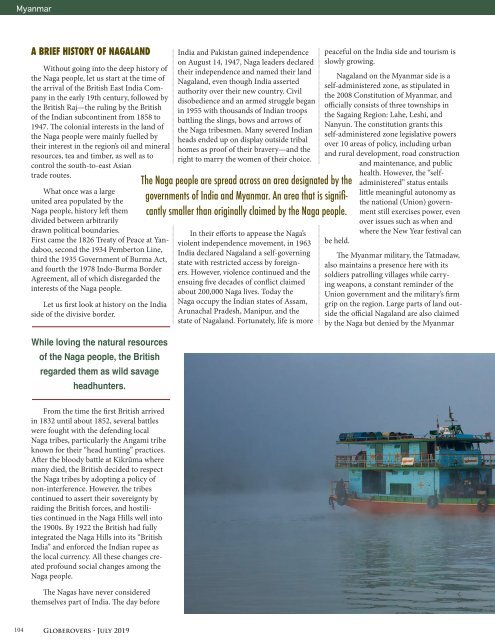Globerovers Magazine, July 2019
GLOBEROVERS MAGAZINE IS NO LONGER ALLOWED TO HAVE MORE THAN 3 ISSUES ON YUMPU UNLESS WE PAY (to provide revenue-generating content to Yumpu!!) SO PLEASE SEE ALL OUR ISSUES FOR FREE ON THESE MAGAZINE PLATFORMS: CALAMEO, MAGZTER, AND ON THE FREE "globerovers" APP. In this 13th issue (July 2019) of Globerovers Magazine, the feature destination is Argentina. We travel from the far north on the border with Bolivia all the way down south to Ushuaia, the gateway to the Antarctic Peninsula. We also have articles about Cyprus and Mauritius Island, Australia, Canada, and we enjoy a colourful New Year Festival with the Naga people in the remote Nagaland region of Myanmar. Photo Essays include the proboscis monkeys and orangutans in Malaysia’s Sabah State on Borneo Island, Peru’s Sacred Valley, and a boat trip down the Li River from Guilin to Yangshuo in China. Furthermore, we have traveller interviews, book reviews, and a lot more! Feedback to editor@globerovers.com. Enjoy!
GLOBEROVERS MAGAZINE IS NO LONGER ALLOWED TO HAVE MORE THAN 3 ISSUES ON YUMPU UNLESS WE PAY (to provide revenue-generating content to Yumpu!!) SO PLEASE SEE ALL OUR ISSUES FOR FREE ON THESE MAGAZINE PLATFORMS: CALAMEO, MAGZTER, AND ON THE FREE "globerovers" APP.
In this 13th issue (July 2019) of Globerovers Magazine, the feature destination is Argentina. We travel from the far north on the border with Bolivia all the way down south to Ushuaia, the gateway to the Antarctic Peninsula.
We also have articles about Cyprus and Mauritius Island, Australia, Canada, and we enjoy a colourful New Year Festival with the Naga people in the remote Nagaland region of Myanmar.
Photo Essays include the proboscis monkeys and orangutans in Malaysia’s Sabah State on Borneo Island, Peru’s Sacred Valley, and a boat trip down the Li River from Guilin to Yangshuo in China.
Furthermore, we have traveller interviews, book reviews, and a lot more!
Feedback to editor@globerovers.com. Enjoy!
You also want an ePaper? Increase the reach of your titles
YUMPU automatically turns print PDFs into web optimized ePapers that Google loves.
Myanmar<br />
A BRIEF HISTORY OF NAGALAND<br />
Without going into the deep history of<br />
the Naga people, let us start at the time of<br />
the arrival of the British East India Company<br />
in the early 19th century, followed by<br />
the British Raj—the ruling by the British<br />
of the Indian subcontinent from 1858 to<br />
1947. The colonial interests in the land of<br />
the Naga people were mainly fuelled by<br />
their interest in the region’s oil and mineral<br />
resources, tea and timber, as well as to<br />
control the south-to-east Asian<br />
trade routes.<br />
What once was a large<br />
united area populated by the<br />
Naga people, history left them<br />
divided between arbitrarily<br />
drawn political boundaries.<br />
First came the 1826 Treaty of Peace at Yandaboo,<br />
second the 1934 Pemberton Line,<br />
third the 1935 Government of Burma Act,<br />
and fourth the 1978 Indo-Burma Border<br />
Agreement, all of which disregarded the<br />
interests of the Naga people.<br />
Let us first look at history on the India<br />
side of the divisive border.<br />
While loving the natural resources<br />
of the Naga people, the British<br />
regarded them as wild savage<br />
headhunters.<br />
India and Pakistan gained independence<br />
on August 14, 1947, Naga leaders declared<br />
their independence and named their land<br />
Nagaland, even though India asserted<br />
authority over their new country. Civil<br />
disobedience and an armed struggle began<br />
in 1955 with thousands of Indian troops<br />
battling the slings, bows and arrows of<br />
the Naga tribesmen. Many severed Indian<br />
heads ended up on display outside tribal<br />
homes as proof of their bravery—and the<br />
right to marry the women of their choice.<br />
The Naga people are spread across an area designated by the<br />
governments of India and Myanmar. An area that is significantly<br />
smaller than originally claimed by the Naga people.<br />
In their efforts to appease the Naga’s<br />
violent independence movement, in 1963<br />
India declared Nagaland a self-governing<br />
state with restricted access by foreigners.<br />
However, violence continued and the<br />
ensuing five decades of conflict claimed<br />
about 200,000 Naga lives. Today the<br />
Naga occupy the Indian states of Assam,<br />
Arunachal Pradesh, Manipur, and the<br />
state of Nagaland. Fortunately, life is more<br />
peaceful on the India side and tourism is<br />
slowly growing.<br />
Nagaland on the Myanmar side is a<br />
self-administered zone, as stipulated in<br />
the 2008 Constitution of Myanmar, and<br />
officially consists of three townships in<br />
the Sagaing Region: Lahe, Leshi, and<br />
Nanyun. The constitution grants this<br />
self-administered zone legislative powers<br />
over 10 areas of policy, including urban<br />
and rural development, road construction<br />
and maintenance, and public<br />
be held.<br />
health. However, the “selfadministered”<br />
status entails<br />
little meaningful autonomy as<br />
the national (Union) government<br />
still exercises power, even<br />
over issues such as when and<br />
where the New Year festival can<br />
The Myanmar military, the Tatmadaw,<br />
also maintains a presence here with its<br />
soldiers patrolling villages while carrying<br />
weapons, a constant reminder of the<br />
Union government and the military’s firm<br />
grip on the region. Large parts of land outside<br />
the official Nagaland are also claimed<br />
by the Naga but denied by the Myanmar<br />
From the time the first British arrived<br />
in 1832 until about 1852, several battles<br />
were fought with the defending local<br />
Naga tribes, particularly the Angami tribe<br />
known for their “head hunting” practices.<br />
After the bloody battle at Kikrüma where<br />
many died, the British decided to respect<br />
the Naga tribes by adopting a policy of<br />
non-interference. However, the tribes<br />
continued to assert their sovereignty by<br />
raiding the British forces, and hostilities<br />
continued in the Naga Hills well into<br />
the 1900s. By 1922 the British had fully<br />
integrated the Naga Hills into its “British<br />
India” and enforced the Indian rupee as<br />
the local currency. All these changes created<br />
profound social changes among the<br />
Naga people.<br />
The Nagas have never considered<br />
themselves part of India. The day before<br />
104 <strong>Globerovers</strong> · <strong>July</strong> <strong>2019</strong>





